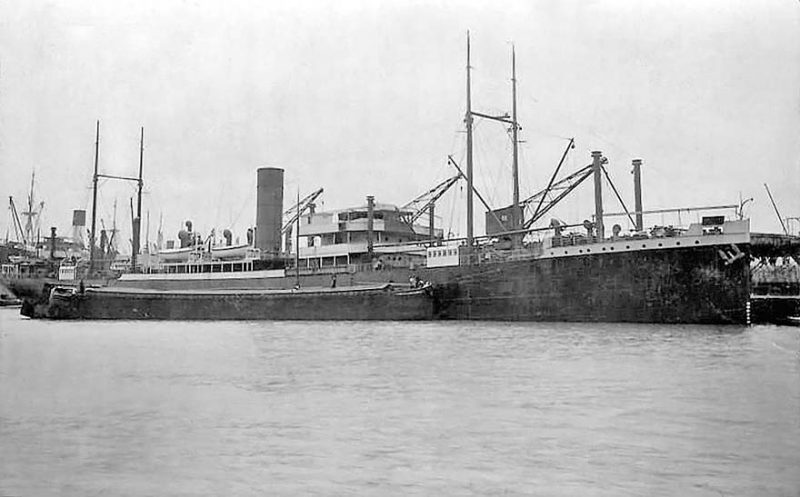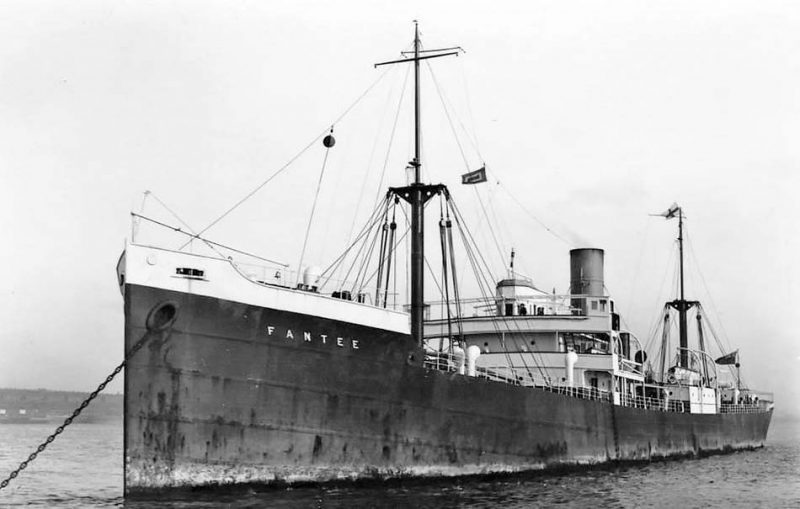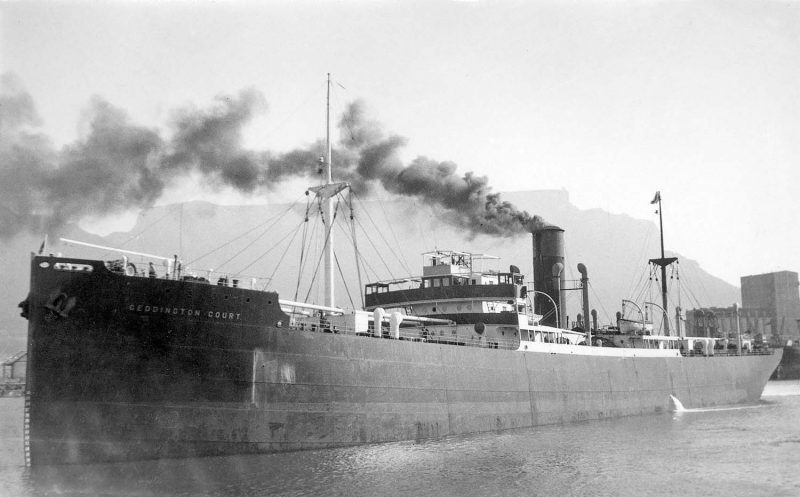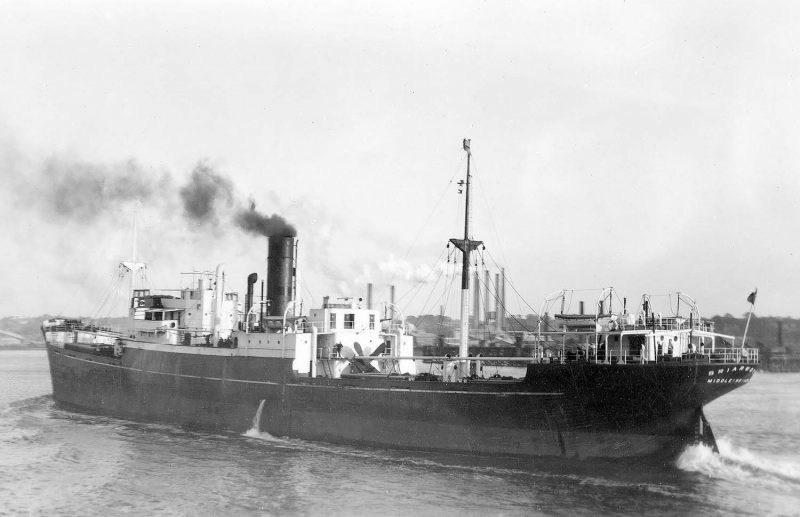The Northumberland Shipbuilding Co. was founded by Rowland Frederick William Hodge, who was born in Sunderland in 1859. At the age of 15 he studied Naval Architecture for five years at a shipyard on the Tyne. He then moved on to ship building companies on the Clyde, before returning to the Tyne. He became a yard manager at C. S. Swan Hunter Co. at Wallsend, representing the company on official trials, and hand over.
In 1898 he acquired a former shipyard at Willington Quay to start his own operations and was its managing director for 20 years. Sir Christopher Furness and John Cory of Cardiff were also major shareholders. The yard had been owned by H. S. Edwards since 1883. He died and the repair side of the business was amalgamated with Smith’s Dock, the shipyard being sold.
The yard had not been very successful before its sale. The machinery was antiquated and needed updating. Hodge implemented a radical update from the start, renewing equipment powered by electricity with a duplicate system as back up. Additional land was bought to give him 11 acres. This allowed him to build a new berth for ships up to 600 feet in length, with a river frontage of 750 feet. 170 houses were also built nearby for the yard’s employees.
At the time there was shortage of skilled labour as many men had been called up to fight in the second Boer War. However, Mr. Hodge did manage to recruit some skilled labour.
Rowland Hodge’s wife launched the first ship, Ravenshoe, 6,000dwt, for John Cory & Son on 11th February 1899.
As had been the case with the Edwards operation, the new firm proposed to build standard hulls only, with the machinery being supplied from other local engine builders. From the beginning the Hodges plan was to cut down on the overheads by building to a standard design for a three island, single deck, 360 feet long ship, with a 7,300 dwt. capacity. The design concept caught the imagination of ship owners and their accountants, reducing the building costs. It proved to be successful with forty five ships being built, several finding their way into various fleets run by Sir Christopher Furness. The only difference between the ships of the class was the arrangement of the superstructures. These were altered to suit the requirements of various owners. The company built the basic hulls only, while the engines initially came from local engineering concerns.
In March 1901 the Queen Christina was launched for Thomas Dunlop Co. Ltd. of Glasgow, a well-known operator of tramp shipping. It was wrecked on a reef off California, when bound from San Francisco to Portland in 1907. Dunlops built a further six ships at the yard.
In the early hours of Sunday 15th July 1900 a fire took hold of a wooden building in the yard containing offices, the drawing office and machine workshops. This had spread from the plate furnaces next to the building which was completely destroyed. The yard had six ships in the berths, but as the plans and other documentation had been destroyed, their completion was delayed. By May 1901 the damaged facilities had been repaired. This coincided with the announcement that Sir Charles Furness and Mr. J. S. Barwick of Sunderland had bought out Rowland Hodge for a large sum. Furness became a large shareholder in the re-formed company and its managing director. The majority of the machinery came from Richardson, Westgarth & Co. which was also part of the Furness industrial empire. There was a ready supply of steel, from Palmers iron and steel furnaces across the river from Willington Quay. Sir Christopher Furness became Chairman there too, from 1910, but he died two years later.
On 27th November 1901 a unique cargo ship was launched for J. R. Christie of London. The 4,487 grt Mercedes was designed for carrying coal from Australia to the bunkering ports on the west coast of South America, and then onto Chinese ports for general cargo. Designed with wide hatches and 40 feet high derrick posts, with 8 huge Temperley Transporters operated by 12 steam winches. These arrangements anticipated a rapid discharge rate of the 7,000 tons of coal from the 4 hatches in 16 hours. With no deep tanks, 15 separate tanks were fitted to accommodate 2,400 tons of water ballast to be trimmed to suit any ballast voyage condition. The ship and its concept interested the Naval Architects at The Admiralty who bought the ship for £37,250 in 1906. The plan was to base her on the China Station. Fitted with a Metcalf Rig she was used in trials of bunkering ships with coal while at sea. The ship remained in the Far East until 1918 when she was then taken over and operated by The Controller of Shipping. At the end of her deployment she was sold to owners in Bilbao in 1920 initially taking the name Juan Olavarriaga. Over the next 16 years she would fly the house flag of 4 other owners from the same port. On 25th October 1936 when sailing as the Elanchove, she sank 150 miles from her home port when transporting iron ore to Cardiff.
On the 19th November 1903 the cargo steamer Gloriana was launched for the British Maritime Trust of West Hartlepool. Within 6 weeks she had been sold to Elder Dempster, and renamed Canada Cape for the service between Montreal and St. John’s to Cape Town. On 4th January 1904 when being towed 5 miles south to Richardson, Westgarth’s Scotia Engine works at Sunderland, the tow rope broke at the entrance to the River Wear. The ship collided with both piers before drifting up stream. In June 1912 the ship caught fire at Cape Town,and was beached and subsequently sold to the Union Steamship Company of New Zealand. With the name Waihemo, she was mined in the Gulf of Athens in March 1918, when on passage from Durban to Piraeus with a cargo of maize.
Such was the demand for a soundly built, cheap no frills cargo ship that the tonnage output from the yard was 40,500 tons in 1904 and in 1911 up to 66,400 tons. Nationally they were only exceeded in tonnage by Swan Hunter & Wigham Richardson and Armstrong, Mitchell & Co. in output from the Tyne before the start of World War I.
A modification to the well-tried product in 1907, gave the design a foot on the beam and a reduction of 15 inches on the draught, but increasing the deadweight to 7,500 tons. This became the new standard, with Graciana (Furness Withy) becoming the first of the class.
Oriana (4,419grt), 3 cyl. engines by Richardson, Westgarth Co. Ltd., 47,240 cu. ft. refrigeration by J. & E. Hall, was completed in August 1902, for British Maritime Trust Ltd. (Furness Withy Co. Ltd. managers). The ship was employed on the Argentine meat trade, and was transferred to the Furness Withy fleet in 1909. Three years later she was taken over by Houlder’s British and Argentine S. cN. Co. Ltd. In 1914 she was sold to Osaka Shosen K. K., Osaka and renamed Java Maru, operating in Pacific waters. In 1923 the refrigeration equipment was removed, and the ship was sold staying under the Japanese flag until being broken up in 1932.
Occasional specialised contracts were also taken on including the Greek emigrant steamer Patris, (4,390/09). She was launched on 23rd December 1908 and careered across the river out of control as the drag chains had parted. The ship collided with, and crashed through the dock gates of Mercantile Dry Docks at Jarrow, seriously damaging the steamer Ilderton (3,125grt/1903) of Steel, Young Co. Ltd., London, which was about to depart at the time. Straddling the dock sill, Patris came close to breaking her back, but was towed off by local tugs on the next tide. A cofferdam had to be built prior to the new dock gate being fitted 5 months later. Patris was built for the Embiricos Brothers service to New York, with accommodation for 60 first class, 47 second class, 34 third class and 1,300 emigrants. During World War I, she was requisitioned (British India S.N. Co. Ltd. as managers), serving between 27th April 1918 to 22nd February 1919, as an Expeditionary Force transport. She was sold in 1924 to Byron S.S. Co. Ltd., (M. Embiricos, managers). She was sold again in 1925, to Messageries Maritimes for the feeder service, between Saigon and Haiphong. She was re-fitted, at La Ciotat, altering the third class cabins and dormitories, to accommodate 548 troops. The ship was renamed Claude Chappe. In early September 1938, a Japanese report stated that the ship had foundered off the Paracel Islands following a fire with the loss off 100 passengers including troops. This was found to be untrue as the ship was docked in Saigon at the time. In 1939 she was sold and broken up at Hong Kong.
Errington Court was completed in August 1909 for Haldinstein Co. Ltd., later to become the Court Line. The ship was the first of 10 built for the company. In early December 1914, she arrived with a cargo of Welsh bunker coal at Port Stanley harbour. On the 8th the crew witnessed the departure of Admiral Sir Doverton Sturdee, with 2 battle cruisers, 3 armoured cruisers and 2 light cruisers where they had been coaling. The British battle group were about to engage Admiral von Spee, and his 5 cruisers who had planned to attack and capture the Island and its base. However Admiral von Spee was unaware of the British fleets presence! Consequently in one the major sea battles of World War I, Germany lost four major German warships, 2,196 seamen and their Admiral. In June 1917 the ship was mined when on passage through the Mediterranean, but salved. Errington Court was sold for the first time in 1919, and by 1938 was owned by G. E. Marden of Shanghai as the Deslock. It was chartered to Miyachi of Japan for trading around the coast of Japan with coal from Muroran to Kawasaki, with occasional voyages to Northern China or Rangoon. When she was berthed in Yokohama on 8th December 1941, she was seized by the Japanese and renamed Uzan Maru. Her end came when she was torpedoed and sunk by the American Submarine U.S.S. Trout when south of Honshu on 2nd May 1942.
Oreland owned by The Noreuro Traders Ltd. (J. F. Drughorn) of London, was launched in November 1911. By 1931 she had been sold and was trading in the Adriatic as the Ante Topic. In 1942 the United States Shipping Administration acquired her under the Panamanian flag. Her war service consisted of voyages from New York to Guantanamo and Cristobal. Her last trans-Atlantic voyage was in the convoy SC 156, which also consisted of 57 ships including 14 tank landing craft, from New York to Liverpool, arriving 13th April 1944. She ended her days in June 1944, being used as part of the Gooseberry Harbour No.1 at Normandy.

In 1912, Kangean (6,857 grt) a 8,700 dwt passenger ship was built for Netherlands Steamship Co., Amsterdam for the Dutch East Indies service, along with pilgrim voyages from Batavia to Mecca. Powered by triple expansion engines, from North Eastern Marine Co. Ltd. which gave her a service speed of 13 knots. On 25th November 1913 she was towed into Lisbon with a serious fire in Nos. 3 & 4 holds. She was sold to Japan for scrapping in 1931 and while lying in Osaka was resold and rebuilt for service as a crab cannery for the Russians, registered to Krabotrest, of Vladivostok, with the name Vsevolod Sibirtsv. The southern half of Sakhalin Island had been ceded to Japan after the 1905 Russo-Japanese war. However in 1945 the Russians seized the opportunity to regain the land and invasion force was landed at three ports. The Vsevolod Sibirtsv was used as a troop transport for the landings at Kholmsk. After the war she resumed her role as a crab cannery until broken up in 1972. Unusually there was very little publicity surrounding this contract in what was the largest ship built at the yard to that date.
Meanwhile in a separate venture, Rowland Hodge also became Chairman of the reconstituted Eltringhams Ltd. shipyard which was modernised and re-opened in 1914 with 5 berths of up to 340 feet long, building patrol boats for The Admiralty and cargo ships up to 5,000dwt. It too closed in 1922 during yet another shipbuilding recession. It had previously been operated by Palmer Brothers who had taken over the defunct Coutts & Parkinson shipyard at Willington Quay on the north bank directly opposite their Jarrow yard in 1859, with 5 building berths between 140 feet to 340 feet long. It was only a few hundred yards upstream from the Northumberland yard.
On 15th May 1897 the last ship to be launched under Palmers name was a light cruiser, H.M.S. Pyramus, 2,740 displacement tons, after which the yard closed. The yard lay dormant until 1912, when a long standing South Shields shipbuilder J. T. Eltringham shut his cramped shipyard, and moved to the old Palmers yard for more space.
Completed in April 1914 for the Hamburg America Line, the Frisia (5,144grt), was seized on 21st August by a Royal Naval patrol, led by the 10-inch gun battleship H.M.S. Triumph, in the Yellow Sea, near Tsingtao (Qingdao), the German enclave, in mainland China. It was the base, for their Far Eastern Cruiser Squadron, commanded by Admiral von Spee. Frisia, loaded with coal, was part of the supporting fleet, that had sailed earlier in the month on its commerce raiding exploits in the South Pacific. She led to two naval engagements with the Royal Navy, the battle of Coronel, and The Falklands, where the squadron was destroyed. Frisia was taken to Hong Kong, and renamed Huntress. She was managed by British India S.N. amongst others. From 1915 she was used as a transport for the British Expeditionary Force. By 1919 she had been handed for service to the South African Government. She was sold in 1930 to Rethymnis & Kulukundis and broken up in Rotterdam the following year.
On 16th June 1917 H.M. King George V & H.M. Queen Mary, on a morale boosting tour of industrial sites in the region, visited Northumberland Shipbuilding Co., Armstrong Whitworth Shipyard at Walker and Smith’s Dock Co. Ltd. at North Shields.
While the main war effort, was rapidly replacing merchant ships lost in the U-boat campaign, a small amount of production was done for The Admiralty. This amounted to four ‘X’ landing craft (X107-X110),and two coastal patrol craft. The ‘X’ craft were of 135 tons displacement, 105.6 feet long, with a cargo capacity of 150 tons or 300 troops, and were powered by J. & C. G. Bolinder 2 cylinder engines, with a speed of 5 knots. Whilst they were no more than motorised barges, they had interesting careers. They were units of a large class, built for the landings during the Dardanelles campaign. Only one of the four was lost during the war, X110 was being towed by the tug Desire from Chatham to Rosyth in January 1918 when stopped 8 miles off Whitby by the German submarine UB-34, which then scuttled her. These craft were next used in the landings by the North Russian Expeditionary Force at Archangel and Murmansk in 1919, aimed at stemming the spread of the revolution.
This was a complete failure which cost the lives of 600 men and cost £49 million! After the war the survivors of the class were put up for sale. In a deal of the utmost secrecy two of the Howden built barges X108 and X109 were sold to the Spanish Government in 1922, and re-designated as K12 and K13.They were used for a large military invasion in September 1925, at Aluchemas, Morocco, where there was an anti-Spanish insurrection in progress. K12 was used by the Republicans during the failed invasion of Mallorca, and fell into the hands of the Nationalists. After this she was used as an inter-island transport around the Balearics. Meanwhile K13 was used for patrols in the Gibraltar Straits. Both of these vessels were still listed as part on the Spanish Navy in 1941.
Before the war started the company designed an even larger class of ship, a 9,700 dwt shelter deck type. Mr. Hodge took his design for a standard ship to the Admiralty and their suitability and quick construction time, meant that the F1 class of thirteen 400 feet, 9,000 dwt vessels would be allocated to his shipyard alone. The first to be built was the Carlow Castle, for Union-Castle and delivered in February 1917. She had been inspected by Admiralty overseers and the order was followed up by a multiple order for more ships 20 months later. By 1935 the Carlow Castle was sailing for Michael J. Carras, under the name Adelfotis. On 1st May 1943 she was torpedoed and sunk by U-182, 500 miles South East of St. Paul’s Rocks.
Another of the class worth a mention was the War Citadel, in that her engines and boilers were installed 63 hours after her launch in November 1918. Like several ships from the shipyard she too became one of the original units of the of the Jugoslavenska Linijska Plovidba, when it was formed in 1946. War Citadel, the second of the ‘F1’ class, was launched on 4th November 1918, with the engines fired up three days later, and the ship was handed over in the same month. The ship passed through several owners, before ending up sailing for Lebanese owners, and was broken up in Osaka in 1959.
None of the class were completed by the time the war ended. The building boom did not last, freight rates slumped and many shipowners with ships on order were in no position to complete deals, leading to many cancellations.

In 1918 Rowland Hodge was convicted of breaking the Government’s Food Hoarding Order, at his home at Coxlodge Hall, Gosforth. The hoard consisted of over a ton of food, consisting of amongst other things, 148 lbs. of bacon and ham, 1,148 lbs. of flour and 85 lbs. of marmalade and jams, 333lbs. of sugar, 4 tins of lobster, 3 tins of crab, 19 tins of salmon etc. He was fined £600 and a further £100 for the hoarding. This was considered an immense social sin during the food shortages during the war. In Court, he blamed his wife saying he was too busy building ships!

After his conviction and disgrace in April 1918, he appears to have severed his connections with the Northumberland Shipbuilding Co.
Rowland Hodge soon afterwards moved to Chipstead, Sevenoaks, Kent, and in due course, Coxlodge Hall and its contents were sold by auction. He then devoted his time to the Commercial Bank of London, with whom he was a director and principal shareholder.
Parliamentary records show that Winston Churchill M.P. was approached by an intermediary who suggested a “production of a baronetcy for a certain Hodge”. If Churchill “delivered the goods”, he would receive a donation of £5,000 for the party. Churchill wrote to Lloyd George warning him, but was ignored. In the 1921 New Year honours Rowland Hodge became the 1st Baron of Chipstead, with the ironical motto of ‘Glory, the reward of virtue’!
Parliamentary records show, that 19 days after the announcement, H.M. King George V’s secretary wrote to Lloyd George expressing annoyance that a man with a ‘notorious career’ and conviction for food hoarding could be awarded a baronetcy.
He was only one of several businessmen, tax-dodgers and fraudsters who acquired a title in exchange for large donations to Lloyd George’s Liberal Government. The scandal eventually brought the government down in 1922.
These details were revealed by researchers for the BBC programme “Who do you think you are”, broadcast on 24th September 2008.
Sir Rowland Hodge as a widower, remarried in 1930 the former Countess of Cathcart, Lady Vera Hodge. She unsuccessively sued her new husband for a divorce in 1934, when he was 75. The case involving jewellery, being rejected for the lack of evidence!
Sir Rowland Hodge passed away 6 days after his 91st birthday in 1950.
The company was sold by Furness Withy in 1918 to Sir Alexander Kennedy’s Sperling financial group, which was overcapitalised, with the shipyard being converted into a public company in 1919. Publicity literature at the time advertised that the yard now had 7 building berths capable of taking ships up to 600 feet long. Sperling also acquired majority holdings in the shipyards of William Doxford (Sunderland), Workman Clark of Belfast, Fairfields and Blythswood of Glasgow. Under the new organisation, Northumberland Shipbuilding Co. Ltd. bought the Chepstow shipyard, formerly National Shipyard No.1, for £600,000 in August 1920. This was renamed and the Monmouth Shipbuilding Co. This had been one of three state sponsored shipyards in an ill-conceived attempt to rebuild the diminished merchant fleet. The Sperling combine soon found itself in trouble, having gambled on a recovery in the market. They ordered 300,000 tons of steel from the steel mills of Dorman Long Co. Ltd. of Teesside, but as the depression lingered they found that the ship orders were not materialising, and they had to compensate the steel mill to the tune of £300,000 for the cancelled order for unused steel. Consequently the company crashed in 1924.
Waikawa laid down as the War Donjon, and was completed in November 1919 for the Union Steamship Co. of New Zealand. By 1941, having passed through several owners hands she was sold to the Iran S.S. Co. All her war time service was conducted in convoys around the Indian Ocean. The ship was lying in Bombay Harbour on 14th April 1944 when the Fort Stikine, with a cargo of ammunition and cotton, blew up. The catastrophe caused 800 deaths and over 3,000 injuries, along with enormous infrastructure damage. Two warships of the Royal Indian Navy and fourteen other merchant ships were also damaged beyond repair.
Elder Dempster owned one F1 type, the Fantee, which was completed in 1920. Laid up in January 1932 in the River Blackwater during the depression, she was sold the next year to Kassos S. N. Co., part of the Rethymnis and Kulukundis combine, taking the name Akti. She was lost following a collision with the Hamburg South America’s steamer La Plata, (8,109grt/1922), off Ushant in December 1938 when bound for Rotterdam from Rio de Janeiro with iron ore.
In 1911 the shipyard had an output of 66,400 tons, but by the start of the slump in 1922 this had fallen to 18,054 tons. In 1920 the yard built 4 steamers for Lloyd Adriatica of Venice.
1921 to 1922 were years of acute general depression in trade all over the country. After a period of feverish activity the post war slump came with unexpected suddenness, and was precipitated by the coal miners’ strike which shut down furnaces and industry.
Only 2 oil tankers were built at the shipyard. The first Modum (6,770dwt) was completed in 1923 for Norwegian owners, but sold to the British Maritime Trust before handover and renamed Peruviana. Within two years she was operating in Argentine waters. The Astranorte (11,305 dwt) joined her, having been built as the Tacito the following year. Both ships remained in service until the early 1960s.
After Yard No. 389, the Chelsea for Brown, Atkinson Co. Ltd. Hull, was completed in November 1925, the yard closed for three years due to the glut of laid-up shipping.

The 6,903grt Geddington Court was built in 1928 for Court Line. In 1951 she became Kyoho Maru of Kyoritsu Kisen KK and in 1957 she was converted into a fish factory ship. She was broken up by Great China Steel & Iron Co. at Kaohsiung in December 1971. Photo: John B Hill Collection
The Northumberland Shipbuilding Co. Ltd. failed once again in 1926 during the continuing shipbuilding slump, and an attempt was made to resurrect it the following year, under the heading of Northumberland Shipbuilding Company (1927) Ltd., reopening in the spring of 1928, with Yard No. 401, the Fiscus for the Tempus Shipping Co. Ltd., Cardiff. The twelve missing yard numbers, reflecting the fragile state of the industry.
Amongst the ships built by the reconstituted company were:-
Geddington Court built for United British S.S. Co. Ltd., known as Court Line after 1936, was 10,146 dwt, launched on 3rd August 1928. Having left Methil on 3rd April 1941 in convoy EN 94 (17 ships) bound for Oban, she was bombed and damaged during an air attack, and had to return to Methil. Repairs took a month to complete. In 1951 she was sold to Japanese interests and renamed Kyoho Maru, a name she kept with two other Japanese companies. The ship was re-engined in 1957 by Mitsubushi, in Yokohama. In 1961 she was converted into a fish factory ship, a role she fulfilled until being broken up 10 years later.
Hadiotis was completed in January 1929, for the Kassos S. N. Co. In 1939 she was one of 15 Greek ships bare-boat chartered to the Federal War Transport Office of Switzerland. Whilst operating for them she was anchored outside Leixoes in bad weather on 15th February 1941 when the Lloyd Brasileiro steamer Cuyaba (6,489grt/1906) ran into her causing major damage. Hadiotis had to be beached, eventually re-floated and towed to Lisbon where she was declared a total loss. However the Swiss Government decided to take ownership, and repair the ship where she lay, with the work being completed by the end of the year, under the name Eiger. The ship was sold in 1949 to the first of 3 subsequent owners, eventually being scrapped in Osaka in 1963 as the Tensho Maru.
Redsea, (5,224 grt) was launched on 24th April 1930 for owners in Hull, and sold in 1938 to Messageries Maritimes. She was renamed Anadyr for their Northern Europe to Far Eastern service. In May 1940 she was evacuating personnel and company documentation from Bordeaux and escaped without damage after being subjected to aerial attack at the entrance to the River Verdon. She was taken over by the Ministry of War Transport, (H. Hogarth managers). The ship was in constant use and on 26th August 1940 she was part of Operation Menace, the failed attack on Dakar by Free French troops. Travelling in convoy TJ 30 from Trinidad she detached from it at Cape Town, and travelled independently when she was torpedoed and sunk 500 miles west of Pernambuco by U-129.

The last ship to come off the slipways at the Howdon yard was the Briarwood (6,485dwt) which was completed for Constantine Shipping Co. Ltd. in July 1930. In 1945 the ship was bought by the Stag Line of North Shields for £70,468 and renamed Gardenia to work on the Great Lakes grain trade. Stag line sold her to Panamanian owners in 1964 for £75,000! In October 1968, when undergoing repairs at Suez, she suffered extensive fire damage to her engine room, and was declared a total loss and was broken up there.
Having built 18 ships, the new company ultimately crashed again in the ongoing gloom, along with many others after the events on Wall Street. In 1930 there were 636 mainly idle building berths in the UK. A total of 343 ships had been built under the Northumberland Shipbuilding banner.
The shipyard’s fate was sealed, when it was sold to the National Shipbuilders Security Ltd. for demolition in 1931.


Comments
Sorry, comments are closed for this item